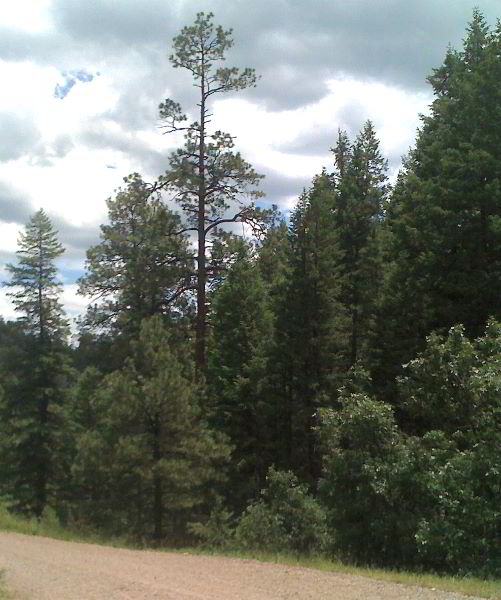ENTS,
Today Monica and I headed toward Pagosa Springs, east of
Durango, to hunt for worthy ponderosas, Doug firs, and blue
spruce. Our destination was the Piedra River. We first went to
the Piedra campground, a short drive off U.S. 160, but the best
I could do was a Doug fir at the edge of the campground that
tips the scales at 120.0 feet in height and 8.3 feet in girth
(31.7" DBH). I left disappointed. We left and went up a Forest
Service Rd paralleling the river. It is one lane with small
pullouts. I didn't want to contend with pickup trucks, RV, etc.
on a very narrow road so we turned around. I have a feeling I
should have been more daring, but the big timber would likely be
at least 10 miles up that drainage, if not farther. The Piedra
will have to wait for another day. With the Piedra ruled out for
the day, we didn't know where else to go, but the drive was very
pleasant. Then on impulsewe decided to go up Forest Service Rd
named First Notch Rd.It is pretty tame, but we did see several
pretty spots. The forest is younger there and the general area
has to contend with more drought than the Hermosa Creek region,
which is an enormous drainage basin with ample protection and
much more water from snow melt, and consequently big trees.
The first tree I felt was worth documenting today was a
ponderosa with the respectable dimensions of: height = 131.0
feet and girth = 8.3 feet (DBH=31.7") The second tree was
a beautiful Doug fir with dimensions: height = 132.5 feet and
girth = 8.5 feet (DBH=32.5"). The ponderosa appeared to be
around 175 years old, the Doug fir maybe 130, if that.
The 3rd and last tree I measured today is just off U.S. 160 on
County Rd 613. It is the youngest of the two ponderosas - maybe
150 years old. Its dimensions are: height = 133.0 feet, girth =
8.9 feet (DBH=34.0"). It is conspicuously taller than the other
pines around it.
All in all, I didn't see any potential for 140s in this
region - not until one gets back into bigger ridges and gulches
Any exceptionally tall trees that might occur will likely be
tucked back into well watered gulches and will be old. A few
exceptions will be along water ways as isolated pines, but few
will make it to 130.
When on our excursions, I am learning to spot the
locations that are worth investigating from greater and greater
distances. Monica and I don't have time to waste. We'll be
heading back up the Hermosa Creek drainage on Monday the 22nd.
I'm determined to add at least one more 150-footer to the list.
A general observation that I'll offer at this time is that the
ponderosas grow a little slower than the white pines in the East
where conditions are favorable to both species. However, given
enough growing time, the tallest ponderosas out here are capable
of reaching to about 90% of the heights of the tallest great
whites in the East. I think it takes big watersheds with lots of
runoff from the high country and lots of forest protection from
wind to produce the forest giants, so examining the terrain on a
map before taking an excursion is time well spent. We'll see in
time how well my crude model works.
Images of the three trees I measured today follow. I apologize
in advance for the pictures not being as good as they should be.
Shooting a pine against a bright background guarantees that
about all that will show up is its silhouette. The alternative
is to shoot the trunk up close, which I do when it is a big
tree. Not much point in shooting the lower trunk of a 30" DBH
pine.

Old Ponderosa on First Notch Road: 131.0 feet tall

Doug fir on First Notch Road: 132.5 feet tall

Ponderosa off County Rd 613: 133.0 feet tall